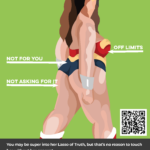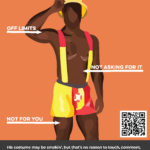HOW DO WE PREVENT INTERPERSONAL VIOLENCE?
EXPLORE SOME STRATEGIES AND CAMPAIGNS BELOW!
Primary prevention is the focus of prevention on the potential perpetrator. Educational efforts attempt to intervene in the behaviors of potential perpetrators before a sexual assault takes place. We know that over 98% of violence is committed by people who identify as male. Therefore, it is not uncommon for primary prevention programs to be targeted towards men. Some of these programs may include men’s groups or activities that begin to unpack violence in hegemonic masculinity. CSU offers students the opportunity to examine masculinity through our men’s group Men in the Movement. Click HERE for more information.
We believe that everyone, regardless of gender can benefit from primary prevention education. Other prevention education efforts include our CTMO campaign, the intro to gender based violence course, as well as many of the books and videos housed in our resource library. Prevention against sexual assault takes a commitment from all genders.
Bystander intervention has been gaining popularity on college campuses in recent years because of its potential to reduce gender violence. The idea behind bystander intervention is basically that from time to time, we all find ourselves in situations where we witness troubling and potentially harmful behavior. At that moment we have the choice to either interrupt the problematic behavior or remain complacent and allow the situation to escalate. The decision to act is not always straightforward and we’ll see how different factors can make “real life” interventions complex. However, the more you learn about bystander intervention the more prepared you’ll be the next time you find yourself witnessing a potentially harmful situation.
While bystander intervention can be implemented as a strategy to reduce a range of social problems, our focus is on how it can be implemented to interrupt gender-based and sexual violence. When it comes to sexual violence on college campuses we believe that bystander intervention complements prevention (link to risk reduction/prevention page) efforts that focus on potential perpetrators (as they are the only ones, who through making the conscious choice to not perpetrate, can truly prevent sexual violence) and risk reduction strategies which focus on potential victims.
While some colleges and universities are heavily invested in bystander intervention, it’s important to remember the limitations of this approach. Often gender-based violence occurs when there aren’t any bystanders around, and when there were other people present, the perpetrator might not exhibit any behavior that would be a recognizable precursor to perpetration. In addition, many bystander intervention programs rely upon and reinforce a type of masculinity that can make for problematic interventions that cause additional harm.
With that said, bystander intervention can still be a useful anti-violence strategy in conjunction with a prevention strategy that tackles systemic oppression.
Risk reduction is the focus of risk reduction on potential victims. Meaning that most risk reduction strategies are targeted towards potential victims or bystanders who learn strategies to use in-the-moment, should an attack or attempted sexual assault happen. Some examples of risk reduction programs include blue safety lights on campus, self-defense classes, bystander intervention techniques, the buddy system, rape whistles, etc.
While some individual people feel safer knowing that risk reduction strategies exist, it can be problematic if a campus only uses risk reduction in its efforts to curb sexual assault and rape. Perhaps the biggest flaw of risk reduction strategies lies in the fact that most strategies are designed for victims to use during a stranger assault. We know that statistically 97% of victims are sexually assaulted by someone they know and trust. Most of these assaults happen within a context where things like mace or pepper spray would not be useful. Most perpetrators of acquaintance rape use manipulation, coercion, and pressure during the assault. And let’s be real, how many of us hold a can of mace in our hands while we are making out with someone “just in case” things start to go farther than we want them to go? It’s just not realistic. Also, risk reduction strategies have the potential to increase victim guilt and self-blame. If a survivor or bystander is trained in self-defense but does not use the techniques (or uses those techniques unsuccessfully) during a sexual assault, it can leave the victim feeling like they should have done more.
WGAC wants to validate and honor that some people feel more empowered to navigate their daily lives after having completed self-defense training. This may be the case for some students at CSU. While we don’t currently offer self-defense classes through the office, we are looking for ways to incorporate similar efforts in a way that feels affirming, safe, and feminist.
SELF-DEFENSE ON A FEMINIST SITE??!!
What’s the first thing that comes to mind when you think of self-defense? Let us guess… a beefy dude in a padded suit teaching women how (and where) to kick an assailant “where it counts”? If that’s what came to mind you might be asking yourself, “what the HECK is self-defense doing on this ‘feminist’ center’s website?!” Give us a moment to explain.
WGAC’s educational programs and victim services are firmly rooted in the philosophy that the only person responsible for preventing a sexual assault is the person who is going to commit it. Therefore, a victim is never at fault for their assault, no matter what they do. Period. End of story.
Having said that, we also recognize that for some people, personal empowerment and self-advocacy involves learning any number of personal protection strategies. For some folks, simple tasks like walking across campus at night, declining a date, speaking up for a promotion at work, speaking in class, etc. feel daunting and at times, impossible.
For this reason, some people (primarily women and queer men) often report feeling more empowered to navigate their daily lives after having completed a personal protection training. WGAC wants to validate and honor that this may be the case for some students at CSU. We are in the process of developing a new curriculum and are committed to addressing the issue of personal protection in a way that feels affirming, victim-centered, safe, and feminist. If you are interested in this topic, check out one of our workshops on campus.
You may have noticed that we tend to use the terms “feminist self-defense” or “personal protection and empowerment”. We do this intentionally because it helps differentiate our philosophy from traditional self-defense courses that primarily focus on physical defense strategies to be used in an instance of stranger assault. While we certainly understand that stranger assault is a real danger for many students, we believe that traditional self-defense curriculums can feel victim-blaming and too often miss the opportunity to broaden conversations about personal safety. The beauty of personal protection and empowerment (or feminist self-defense) is that the movement includes strategies to address a wide range of issues related to overall empowerment and self-advocacy in multiple facets of our lives.
Here are a few examples of the things that can fall under the umbrella of personal protection/empowerment/feminist self defense:
- Self-empowerment tactics—these include knowing your own personal boundaries, feeling good about your body, having self confidence in expressing your desires and needs
- “In the moment” anti-violence tactics—these include things like strategies for escaping from a hold, throwing punches & kicks, how and what to scream, etc.
- Safety Planning tactics—these include things like the buddy system, safewalk, ramride, carrying mace, or any other plan that is made ahead of time.
- Community response tactics—these include things like community watch groups, “bad date” books, the Hollaback movement, etc.
- Bystander intervention tactics—these strategies include teaching people to recognize red flags in potentially non-consensual interactions and offers tips for feeling empowered to intervene in sexist/racist/homophobic/etc. situations
CHECK OUT SOME OF OUR ANTI-VIOLENCE CAMPAIGNS BELOW!
Jeepers Creepers is a Scooby-Doo inspired social media campaign about peeping, stalking, and harassment behaviors intended to educate readers about peeping and offer resources to those who may be experiencing it.
Check it out on our Instagram!
More information about peeping soon to come! Need support now? Many strategies for navigating peeping are similar to strategies for navigating stalking. Check out our page on stalking for more information. To speak with a confidential advocate, you can use our chat feature or call our 24/7 Victim Assistance Team (VAT) hotline at 970-492-4242.




